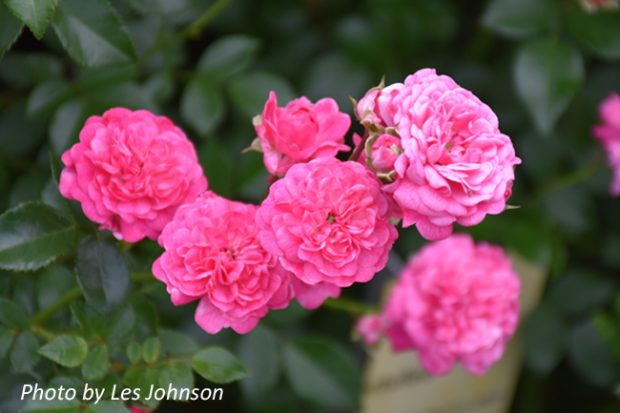Each season the Rose Society of South Australia releases cultural notes, which are recommendations from the experts on how to care for your roses. Here are the winter cultural notes from Gavin Woods, Past President of the RSSA and the National Rose Society of Australia. Gavin is also Chief Judge with the RSSA and an International Rose Judge accredited with the World Federation of Rose Societies. The photos are of the Rose Society’s Rose of the Month – ‘Pepita’.
With cold nights upon us, we will soon see the decline in growth on our roses as we watch them enter a brief winter dormancy. I am anticipating a cold and wet end to autumn, and if my predictions are correct, we will probably see an explosion of fungal disease on our plants. The dry spring and summer saw very little disease on the roses in my garden, however the spores will be around just waiting for the right conditions. This, along with low minimum temperatures may see many roses well defoliated at pruning time.
Winter pruning is the most arduous physical task undertaken in the rose garden every year, but is less daunting if you are well prepared and allow adequate time to complete the chore un-rushed. Pruning roses requires some equipment – namely, secateurs, loppers to cut thick canes, a pruning saw to tackle really old canes, and of course, gloves. Tools should be prepared well ahead of time; secateurs and loppers oiled and sharpened and saws cleaned. A good set of tools will make the chore of pruning so much more enjoyable.

The timing of pruning roses is a much debated one. I recommend that under normal circumstances, roses in South Australia should not be pruned before July 1st and should ideally be completed prior to the second week in August. There will always be exceptions, and some pockets of the state may experience heavy frost which would necessitate slightly later pruning. May pruning often results in the plants putting on early new growth which may suffer with the cold of late July and August.
If Neutrog’s Seamungus was not applied to the entire rose garden prior to pruning, do it soon afterwards. This outstanding soil treatment is a vital component of the nutrient cycle to produce the best from our roses. It will be carried into the soil by winter rains.
By September, roses will be putting on considerable new growth. Early signs of Black Spot will show itself on susceptible varieties, best managed by simply removing the affected leaves and placing them in a plastic bag for disposal. Irrigation will need to begin by early September in most gardens.
Sudden Impact for Roses should be applied by mid-September. The warmer soil temperatures and applications of water will see this fantastic product soon taken into the soil for the benefit of our roses. Applications of GOGO Juice can begin this month also. Whilst of benefit to the entire micro-bacterial structure of the soil, I particularly recommend this product for three specific areas. Firstly when establishing new beds for roses or smaller areas within established beds, GOGO Juice is of enormous benefit in re-establishing the life of the soil. Secondly, I apply it monthly via watering and directly to new roses, and thirdly I believe it markedly aids the rehabilitation of old and ailing roses.

The winter fungicide spray is the most critical of the whole year. I usually apply a Lime Sulphur spray soon after pruning. There is potential for sulphur to burn new growth should this spray be delayed too long after pruning. This spray emits a pungent odour, however it is relatively short lived. I like to use a second spray of white oil (Winter Oil, Pest Oil etc) two weeks after the sulphur spray. Oil based sprays have a double efficacy; they will deal with residual fungal spores and they will kill any pests that have survived the winter, provided the spray hits them. Some years ago I developed a problem with Wooly Scale and oil sprays have kept that pest under control. If good hygiene practices are adopted in winter including a spraying programme, the need for ongoing anti-fungal sprays during the growing season can be reduced.
Winter is also the time to plant bare-root roses. The retail nurseries begin delivery of plants in June and will often forward until the end of August. Planting past August is not ideal, but could be extended until very early September if there is no option. If you cannot plant your new arrivals upon delivery, I would recommend potting them and delaying planting until November. Potting a plant only to remove it and plant into the ground before the first flush of bloom risks breaking too many new roots and thus setting the plant back.
After the new arrivals have been unpacked, I like to soak the entire plant in a deep tub of liquid Seamungus for 24-48 hours. This allows the plant to re-hydrate and perhaps to stimulate the roots into growth. Planting with a good soak also using liquid Seamungus should see the best possible start to the 20 years or so of blooms that the rose will provide. Settle the plants into the soil with the bud-union (or crown) at soil level. Mulching later will see the crown covered and protected from the damaging summer sun.
With your roses now bare sticks, there is no easier time to mulch. Whoflungdung has completed the cycle of requirements for getting the very best from our plants. Spread it some 4cm or so thick around the plants. Several prominent growers are crediting this mulch with vastly increased performance from their roses.
The Rose Society of South Australia are happy to welcome new members, so if you have a keen interest in roses and want to learn from the experts, this is the best place. For more information, visit https://sarose.org.au/about/membership/
